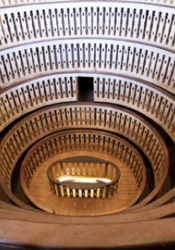First Anatomical Theatre, Padua
Implemented by the University of Padua, the first anatomical theatre was built as both a teaching tool and a gathering place to discuss medical science. The design, based on a traditional amphitheater, included a center table for cadaver work surrounded by elevated rows of seats and railings for observers to gain a clear view of the dissection. Typically, skeletons from previous dissections were including in a viewing, along with instructional banners. A chief surgeon leading the meeting normally didn’t perform the actualcutting, as hired dissectors or students would follow his instructions during the viewing. Due to the large seating capacity, viewing of dissections became popular, spurring the construction of similar theatres accross Northern Italy and making the region the center of anatomical research decades. Over the course of the next few centuries, anatomical theatres following a similar design were built across Europe.
Source:
Klestinec, Cynthia. “A History of Anatomy Theatres in Sixteenth-Century Padua.” Journal of History of Medicine and Allied Sciences. US National Library of Medicine, July, 2004. Web. 15 Feb. 2018. Link
Image Source:
Image is courtesy of VenetoInside.com. Image can be found on the website

